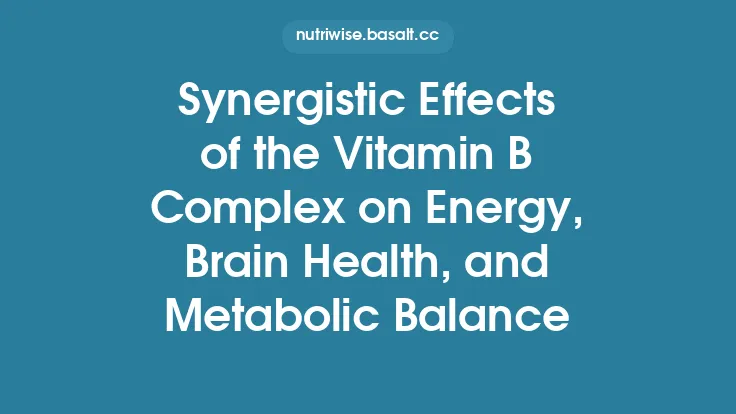The tricarboxylic acid (TCA) cycle sits at the crossroads of cellular metabolism, acting not only as a hub for oxidizing acetyl‑CoA to CO₂ but also as a source of carbon skeletons for a myriad of biosynthetic processes. Because the cycle’s intermediates are continuously siphoned off for anabolic needs—such as amino‑acid synthesis, gluconeogenesis, and lipid formation—the pool of TCA metabolites would gradually dwindle unless it is replenished. This dynamic equilibrium between the removal of intermediates (cataplerosis) and their replenishment (anaplerosis) is essential for maintaining the cycle’s flux, ensuring that energy production and biosynthesis can proceed in tandem. Understanding how the body draws on digested nutrients to support these opposing flows provides insight into the subtle ways diet influences cellular metabolism beyond simple caloric content.
Why the TCA Cycle Needs Balance
The TCA cycle comprises eight distinct metabolites, each capable of serving as a precursor for downstream pathways. When a cell is actively synthesizing non‑essential amino acids, for example, oxaloacetate may be diverted to form aspartate, while α‑ketoglutarate can be extracted for glutamate production. Such withdrawals, termed cataplerosis, lower the concentration of cycle intermediates and can slow the rate at which acetyl‑CoA is oxidized. Conversely, anaplerotic reactions inject carbon back into the cycle, restoring the pool of intermediates and preserving the cycle’s capacity to generate reducing equivalents for downstream energy‑producing steps.
A balanced TCA cycle is therefore a prerequisite for:
- Sustained ATP generation – even though the primary focus here is on the cycle’s biosynthetic role, a sufficient supply of intermediates indirectly supports the production of NADH and FADH₂ that feed the electron transport chain.
- Metabolic flexibility – the ability of tissues to switch between carbohydrate, fat, and protein substrates hinges on a well‑stocked TCA pool.
- Homeostatic control of blood glucose – gluconeogenic precursors derived from TCA intermediates help maintain plasma glucose during fasting.
Key Anaplerotic Pathways from Dietary Nutrients
While the TCA cycle can generate many of its own intermediates through internal rearrangements, several nutrients provide direct anaplerotic inputs. The most prominent sources include:
| Nutrient | Primary Anaplerotic Reaction | Enzyme(s) Involved | Net Carbon Contribution |
|---|---|---|---|
| Glutamine | Glutaminase converts glutamine → glutamate → α‑ketoglutarate | Glutaminase, Glutamate dehydrogenase | +5‑carbon (α‑ketoglutarate) |
| Propionate (from odd‑chain fatty acids, certain gut‑derived SCFAs) | Propionyl‑CoA → methylmalonyl‑CoA → succinyl‑CoA | Propionyl‑CoA carboxylase, methylmalonyl‑CoA mutase | +4‑carbon (succinyl‑CoA) |
| Pyruvate (from glycolytic end‑product of carbohydrate digestion) | Pyruvate carboxylase adds CO₂ to pyruvate → oxaloacetate | Pyruvate carboxylase | +4‑carbon (oxaloacetate) |
| Amino acids (e.g., valine, isoleucine, threonine) | Transamination/deamination yields succinyl‑CoA or α‑ketoglutarate | Various aminotransferases, dehydrogenases | +4‑ or +5‑carbon depending on the amino acid |
| Acetate (produced by gut microbiota) | Acetyl‑CoA can be converted to citrate via citrate synthase, then cleaved by ATP‑citrate lyase to generate oxaloacetate and acetyl‑CoA for biosynthesis | Citrate synthase, ATP‑citrate lyase | Indirectly supports anaplerosis by providing citrate for cytosolic pathways that recycle oxaloacetate |
Glutamine: The “Nitrogen Shuttle”
Glutamine is often described as the most versatile anaplerotic substrate because it simultaneously supplies carbon and nitrogen. After deamidation, glutamate is deaminated to α‑ketoglutarate, directly feeding the TCA cycle. In rapidly proliferating cells—such as immune cells activated after a meal—this pathway becomes especially important, allowing the cell to sustain both energy production and the synthesis of nucleotides and non‑essential amino acids.
Propionate and Odd‑Chain Fatty Acids
Although dietary fat is typically even‑chain, certain foods (e.g., dairy fat) contain odd‑chain fatty acids that yield propionyl‑CoA upon β‑oxidation. Propionate’s conversion to succinyl‑CoA is a classic anaplerotic route that bypasses the need for pyruvate carboxylation, making it valuable during periods when carbohydrate intake is low.
Pyruvate Carboxylation
Carbohydrate digestion ultimately produces glucose, which is metabolized to pyruvate. In the mitochondria, pyruvate carboxylase catalyzes the ATP‑dependent addition of CO₂ to pyruvate, forming oxaloacetate. This reaction is a cornerstone of anaplerosis, especially in liver and kidney cells where gluconeogenesis is active.
Major Cataplerotic Routes and Their Physiological Roles
Cataplerosis is the purposeful removal of TCA intermediates for biosynthetic or regulatory purposes. The most physiologically relevant cataplerotic fluxes include:
- Aspartate synthesis – Oxaloacetate transamination yields aspartate, a precursor for nucleotide biosynthesis and the urea cycle.
- Glutamate and glutamine production – α‑Ketoglutarate transamination forms glutamate, which can be amidated to glutamine for nitrogen transport.
- Citrate export for fatty acid synthesis – Mitochondrial citrate can be shuttled to the cytosol, where ATP‑citrate lyase cleaves it into oxaloacetate and acetyl‑CoA, the latter serving as the building block for de novo lipogenesis.
- Malate export for NADPH generation – Cytosolic malic enzyme converts malate to pyruvate while producing NADPH, essential for reductive biosynthesis and antioxidant defenses.
These cataplerotic pathways are not random leaks; they are tightly regulated to match cellular demands. For instance, during post‑prandial lipogenesis, the export of citrate is up‑regulated, while during fasting, the demand for oxaloacetate in gluconeogenesis drives increased pyruvate carboxylase activity.
Regulatory Mechanisms that Coordinate Anaplerosis and Cataplerosis
The cell employs several layers of control to keep the TCA pool in equilibrium:
- Allosteric modulation of key enzymes – Pyruvate carboxylase is activated by acetyl‑CoA (signaling abundant fuel) and inhibited by ADP, ensuring that anaplerosis proceeds when energy is plentiful. Conversely, citrate synthase is inhibited by high concentrations of ATP and NADH, tempering flux when the cycle is saturated.
- Substrate availability – The concentration of anaplerotic substrates (e.g., glutamine, propionate) directly influences the rate of entry into the cycle. Dietary patterns that enrich these substrates can shift the balance toward anaplerosis.
- Compartmentalized transporters – Mitochondrial carriers such as the citrate transporter (SLC25A1) and the malate‑α‑ketoglutarate exchanger (SLC25A11) regulate the movement of intermediates between mitochondria and cytosol, thereby modulating cataplerotic output.
- Hormonal cues (indirectly) – While the article avoids deep discussion of hormonal regulation, it is worth noting that insulin‑mediated activation of phosphofructokinase‑2 indirectly raises glycolytic pyruvate levels, feeding pyruvate carboxylase. Glucagon, on the other hand, promotes cataplerotic export of citrate for gluconeogenesis.
Nutritional Implications and Dietary Strategies
Understanding anaplerosis and cataplerosis offers practical guidance for designing diets that support metabolic health:
- Incorporate glutamine‑rich foods – Protein sources such as dairy, legumes, and certain meats provide glutamine, bolstering the α‑ketoglutarate pool.
- Include odd‑chain fatty acids – Full‑fat dairy products and certain fish oils contain odd‑chain fatty acids that can be metabolized to propionate, offering a non‑carbohydrate anaplerotic route.
- Balance carbohydrate intake – Adequate carbohydrate consumption ensures a steady supply of pyruvate for oxaloacetate replenishment via pyruvate carboxylase, especially important for tissues with high gluconeogenic demand (e.g., kidney).
- Support gut microbiota – Fermentation of dietary fibers produces short‑chain fatty acids, including propionate, which can be absorbed and utilized anaplerotically. A diet rich in diverse fibers thus indirectly contributes to TCA cycle balance.
- Timing of nutrient intake – Consuming protein or carbohydrate-rich meals after periods of fasting can help restore depleted TCA intermediates, facilitating a smoother transition back to an anabolic state.
Clinical Relevance and Metabolic Disorders
Disruptions in the anaplerotic‑cataplerotic balance are implicated in several pathophysiological conditions:
- Inborn errors of metabolism – Deficiencies in enzymes such as propionyl‑CoA carboxylase (propionic acidemia) or pyruvate carboxylase lead to accumulation of toxic metabolites and impaired TCA function.
- Heart failure – The myocardium relies heavily on anaplerosis (particularly via glutamine) to maintain TCA flux under stress. Reduced anaplerotic capacity contributes to energetic deficits in failing hearts.
- Cancer metabolism – Rapidly proliferating tumor cells often up‑regulate glutaminolysis to fuel anaplerosis, a phenomenon termed “glutamine addiction.” Targeting glutaminase has emerged as a therapeutic strategy.
- Neurodegenerative diseases – Neurons depend on anaplerotic replenishment of oxaloacetate for neurotransmitter synthesis (e.g., aspartate, glutamate). Impaired anaplerosis may exacerbate excitotoxicity.
Therapeutic approaches that modulate anaplerotic substrates—such as supplementation with anaplerotic precursors (e.g., tri‑valerate, a propionate ester) or dietary manipulation—are under active investigation.
Research Frontiers and Emerging Insights
The field continues to uncover nuanced aspects of TCA cycle balance:
- Mitochondrial metabolite channeling – Advanced imaging and isotope tracing reveal that certain enzymes form transient complexes, allowing direct hand‑off of intermediates and reducing the need for bulk diffusion.
- Allosteric regulation by metabolites – Recent studies suggest that metabolites like succinate and fumarate can act as signaling molecules, influencing gene expression and epigenetic modifications, thereby linking anaplerosis to broader cellular responses.
- Microbiome‑derived anaplerotics – Beyond propionate, other microbial metabolites (e.g., butyrate, lactate) may be converted into TCA intermediates, highlighting a symbiotic dimension to metabolic homeostasis.
- Personalized nutrition – Metabolomic profiling can identify individual variations in anaplerotic capacity, paving the way for diet plans tailored to optimize TCA cycle balance for health or performance goals.
By appreciating the delicate dance between anaplerosis and cataplerosis, scientists and nutritionists alike can better predict how dietary choices translate into cellular function, ultimately informing strategies to maintain metabolic health across the lifespan.





